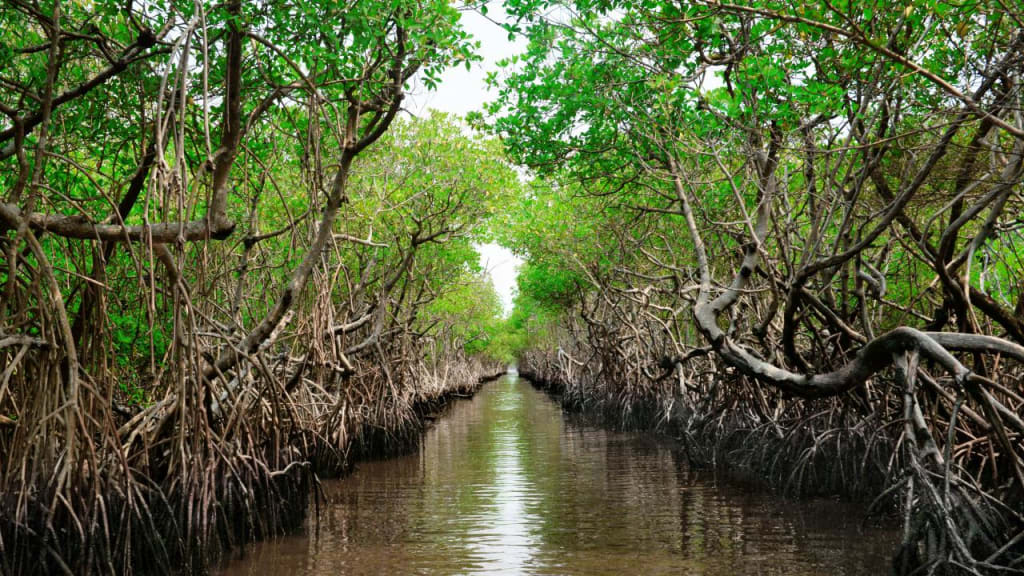Only Mangrove forest in the world
The Enchanting Realm of Mangrove Forests: Exploring Nature's Coastal Guardians

Mangrove forests, often referred to as the "rainforests by the sea," are captivating ecosystems that thrive in the dynamic interface between land and sea. These unique coastal wetlands are found in tropical and subtropical regions around the world, where they play vital roles in biodiversity conservation, shoreline protection, carbon sequestration, and the sustenance of local communities. With their intertwining roots, diverse flora and fauna, and ecological significance, mangrove forests stand as some of the most remarkable and resilient ecosystems on the planet.
Mangroves: A Unique Habitat:
Mangroves are not simply forests that happen to grow near water; they are ecosystems that have evolved to thrive in the challenging conditions of coastal zones. These habitats are often characterized by fluctuating salinity, tidal influence, and sediment-rich waters. Despite these challenges, mangroves have adapted remarkable survival strategies. Their distinctive root systems, which include prop roots, aerial roots, and pneumatophores, enable them to anchor themselves in the soft, muddy substrate and access oxygen, even when submerged.
Global Distribution and Diversity:
Mangrove forests are found in over 118 countries across the globe, spanning continents such as Asia, Africa, the Americas, and Oceania. The range of species found in these forests can vary based on regional characteristics, but they all share the ability to tolerate saline conditions. Some common mangrove tree species include the red mangrove (Rhizophora spp.), black mangrove (Avicennia spp.), and white mangrove (Laguncularia racemosa).
Ecological Significance:
Mangrove forests are of immense ecological importance. They provide critical nursery habitats for various marine species, including fish, crustaceans, and mollusks. These nursery areas offer shelter and abundant food, allowing juvenile organisms to grow and thrive before venturing into the open sea. This ecological role makes mangroves vital for the health of fisheries and marine biodiversity.
Carbon Storage and Climate Resilience:
Mangroves are remarkable carbon sequesters. The dense vegetation of these forests absorbs and stores significant amounts of carbon dioxide from the atmosphere. Additionally, the sediment trapped by mangrove roots captures carbon, preventing it from reentering the atmosphere or being released into the ocean. This carbon storage potential makes mangroves valuable allies in the fight against climate change.
Coastal Protection:
Mangroves act as natural coastal defenses, shielding shorelines from erosion, storm surges, and tsunamis. The complex root systems of mangrove trees help stabilize sediments and reduce the impact of waves, effectively protecting nearby communities and infrastructure. The buffering effect of mangroves is especially vital in regions prone to extreme weather events.
Economic and Societal Value:
Mangrove forests contribute to the livelihoods of millions of people around the world. Local communities rely on these ecosystems for sustenance through fishing and gathering resources such as wood and non-timber forest products. Additionally, mangrove-based ecotourism provides economic opportunities while raising awareness about the value of these habitats.
Challenges and Conservation Efforts:
Despite their ecological significance, mangrove forests are under threat due to factors such as urban development, aquaculture expansion, pollution, and climate change. The loss of mangroves can have cascading impacts on biodiversity, coastal protection, and carbon storage. Conservation efforts are crucial to preserving these ecosystems, and initiatives range from protected area designations to community-based restoration projects.
Sustainable Management and Restoration:
Sustainable management of mangrove forests involves a balance between human needs and ecological preservation. In some cases, mangrove restoration projects are initiated to reverse habitat loss and promote the recovery of these vital ecosystems. Community engagement, scientific research, and collaboration among governments, NGOs, and local communities play essential roles in ensuring the long-term health of mangrove forests.
Conclusion:
Mangrove forests are nature's guardians of the coastline, offering a wealth of ecological, economic, and societal benefits. From their unique adaptations to their roles in carbon sequestration, biodiversity conservation, and coastal protection, these ecosystems embody the intricate interplay between land and sea. As we navigate the challenges of the modern world, preserving and valuing mangrove forests is not only an ecological imperative but a testament to the intricate beauty and resilience of the natural world. These "rainforests by the sea" remind us of the vital importance of protecting and coexisting with the delicate balance of Earth's diverse ecosystems.





Comments
There are no comments for this story
Be the first to respond and start the conversation.